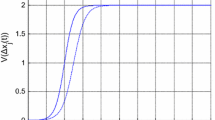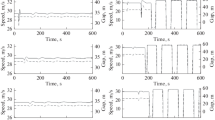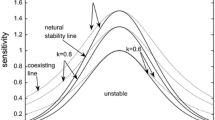Abstract
In this paper, we propose an extension of the optimal velocity car-following model to consider explicitly the timid and aggressive driving behavior as well as the traffic jerk. The linear stability condition of the new model is derived, where the effect of traffic jerk and intensity of influence of drivers’ behavior on the traffic flow stability is investigated. By applying the reductive perturbation method, we derive a modified Korteweg–de Vries equation near the critical point to describe the evolution properties of traffic density waves via nonlinear stability analysis. The results show that the provision of aggressive drivers is a greater contributor to improving the stability of traffic flow compared to the timid ones in the context of traffic jerk, and that the stability of traffic flow can be improved by the provision of well-experienced drivers.













Similar content being viewed by others
References
Redhu, P., Gupta, A.K.: Effect of forward looking sites on a multi-phase lattice hydrodynamic model. Phys. A Stat. Mech. Appl. 445, 150–160 (2016)
Gupta, A.K., Sharma, S., Redhu, P.: Effect of multi-phase optimal velocity function on jamming transition in a lattice hydrodynamic model with passing. Nonlinear Dyn. 80(3), 1091–1108 (2015)
Gupta, A.K., Dhiman, I.: Phase diagram of a continuum traffic flow model with a static bottleneck. Nonlinear Dyn. 79(1), 663–671 (2015)
Gupta, A.K., Redhu, P.: Analyses of the driver’s anticipation effect in a new lattice hydrodynamic traffic flow model with passing. Nonlinear Dyn. 76(2), 1001–1011 (2014)
Chen, M., Barwolff, G.K.F., Schwandt, H.: A study of step calculations in traffic cellular automaton models. In: Conference record - IEEE conference on intelligent transportation systems, pp 747–752 (2010). https://doi.org/10.1109/ITSC.2010.5625180
Bouadi, M., Jetto, K., Benyoussef, A., et al.: The investigation of the reentrance phenomenon in cellular automaton traffic flow model. Phys. A Stat. Mech. Appl. 469, 1–14 (2017)
Zhao, H.T., Yang, S., Chen, X.X.: Cellular automata model for urban road traffic flow considering pedestrian crossing street. Phys. A Stat. Mech. Appl. 462, 1301–1313 (2016)
Li, Q.L., Wong, S.C., Min, J., et al.: A cellular automata traffic flow model considering the heterogeneity of acceleration and delay probability. Phys. A Stat. Mech. Appl. 456, 128–134 (2016)
Tampère, C.M.J., Arem, B.V., Hoogendoorn, S.P.: Gas-kinetic traffic flow modeling including continuous driver behavior models. Transp. Res. Rec. J Transp. Res. Board 1852(1), 231–238 (2002)
Zhao, J.Y., Sun, X.M., Jia, L.: An improvement of relaxation time of gas-kinetic traffic model. Acta Phys. Sin. 55(5), 2306–2312 (2006)
Zhao, X., Gao, Z.: A new car-following model: full velocity and acceleration difference model. Eur. Phys. J. B 47(1), 145–150 (2005)
Tang, T.Q., Li, C.Y., Huang, H.J.: A new car-following model with the consideration of the driver’s forecast effect. Phys. Lett. A 374(38), 3951–3956 (2010)
Tang, T., Wang, Y., Yang, X., et al.: A new car-following model accounting for varying road condition. Nonlinear Dyn. 70(2), 1397–1405 (2012)
Tang, T.Q., Wu, Y.H., Caccetta, L., et al.: A new car-following model with consideration of roadside memorial. Phys. Lett. A 375(44), 3845–3850 (2011)
Bando, M., Hasebe, K., Nakayama, A., et al.: Dynamical model of traffic congestion and numerical simulation. Phys. Rev. E Stat. Phys. Plasmas Fluids Relat. Interdiscip. Top. 51(2), 1035–1042 (1995)
Helbing, D., Treiber, M.: Numerical simulation of macroscopic traffic equations. Comput. Sci. Eng. 1(5), 89–98 (1999)
Jiang, R., Wu, Q., Zhu, Z.: Full velocity difference model for a car-following theory. Phys. Rev. E 64, 017101–017104 (2001)
Yu, S., Huang, M., Ren, J., et al.: An improved car-following model considering velocity fluctuation of the immediately ahead car. Phys. A Stat. Mech. Appl. 449, 1–17 (2015)
Zhang, G., Zhao, M., Sun, D.H., et al.: Stabilization effect of multiple drivers’ desired velocities in car-following theory. Phys. A Stat. Mech. Appl. 442, 532–540 (2016)
Sun, D., Kang, Y., Yang, S.: A novel car following model considering average speed of preceding vehicles group. Phys. A Stat. Mech. Appl. 436, 103–109 (2015)
Liu, L., Zhu, L., Yang, D.: Modeling and simulation of the car-truck heterogeneous traffic flow based on a nonlinear car-following model. Appl. Math. Comput. 273, 706–717 (2016)
Saifuzzaman, M., Haque, M.M., Zheng, Z., et al.: Impact of mobile phone use on car-following behaviour of young drivers. Accid. Anal. Prev. 82, 10–19 (2015)
Tang, T.Q., Shi, W.F., Shang, H.Y., et al.: An extended car-following model with consideration of the reliability of inter-vehicle communication. Measurement 58(11), 286–293 (2014)
Reichardt, D., Miglietta, M., Moretti, L., et al.: CarTALK 2000: safe and comfortable driving based upon inter-vehicle-communication. In: Intelligent Vehicle Symposium. IEEE Xplore, vol. 2, pp .545–550 (2002)
Kerner, B.S., Klenov, S.L., Brakemeier, A.: Testbed for wireless vehicle communication: a simulation approach based on three-phase traffic theory. In: Intelligent Vehicles Symposium. IEEE Xplore, pp. 180–185 (2007)
Guo, L., Zhao, X., Yu, S., et al.: An improved car-following model with multiple preceding cars’ velocity fluctuation feedback. Phys. A Stat. Mech. Appl. 471, 436–444 (2017)
Tang, T.Q., Xu, K.W., Yang, S.C., et al.: Analysis of the traditional vehicle’s running cost and the electric vehicle’s running cost under car-following model. Mod. Phys. Lett. B 30(7), 1650084–1650092 (2016)
Tang, T.Q., Yi, Z.Y., Lin, Q.F.: Effects of signal light on the fuel consumption and emissions under car-following model. Phys. A Stat. Mech. Appl. 469, 200–205 (2016)
Ge, H.X., Zheng, P.J., Wang, W., et al.: The car following model considering traffic jerk. Phys. A Stat. Mech. Appl. 433, 274–278 (2015)
Liu, F., Cheng, R., Zheng, P., et al.: TDGL and mKdV equations for car-following model considering traffic jerk. Nonlinear Dyn. 83(1–2), 1–8 (2015)
Liu, Y., Cheng, R.J., Lei, L., et al.: The influence of the non-motor vehicles for the car-following model considering traffic jerk. Phys. A Stat. Mech. Appl. 463, 376–382 (2016)
Peng, G., He, H., Lu, W.Z.: A new car-following model with the consideration of incorporating timid and aggressive driving behaviors. Phys. A Stat. Mech. Appl. 442, 197–202 (2016)
Cheng, R., Ge, H., Wang, J.: An extended continuum model accounting for the driver’s timid and aggressive attributions. Phys. Lett. A 381(15), 1302–1312 (2017)
Kaur, R., Sharma, S.: Analysis of driver’s characteristics on a curved road in a lattice model. Phys. A Stat. Mech. Appl. 471, 59–67 (2017)
Zhang, G., Sun, D.H., Liu, W.N., et al.: Analysis of two-lane lattice hydrodynamic model with consideration of drivers’ characteristics. Phys. A Stat. Mech. Appl. 422, 16–24 (2015)
Sharma, S.: Lattice hydrodynamic modeling of two-lane traffic flow with timid and aggressive driving behavior. Phys. A Stat. Mech. Appl. 421(1), 401–411 (2015)
Acknowledgements
The helpful comments from anonymous reviewers are gratefully acknowledged. This work is supported by the National Science Foundation of China (Project No. 61703165), the China Postdoctoral Science Foundation (Project No. 2016M600653) and the fundamental Research Funds for the Central Universities (Project No. D2171990).
Author information
Authors and Affiliations
Corresponding author
Ethics declarations
Conflicts of interest
The authors declare that they have no conflict of interest.
Ethical statement
I certify that this manuscript is original and has not been published and will not be submitted elsewhere for publication. And the study is not split up into several parts to increase the quantity of submissions and submitted to various journals or to one journal over time. No data have been fabricated or manipulated (including images) to support your conclusions. No data, text, or theories by others are presented as if they were our own. The submission has been received explicitly from all co-authors. And authors whose names appear on the submission have contributed sufficiently to the scientific work and therefore share collective responsibility and accountability for the results.
Human and animals participants
This article does not contain any studies with human participants or animals performed by any of the authors.
Informed consent
Informed consent was obtained from all individual participants included in the study.”
Rights and permissions
About this article
Cite this article
Zhai, C., Wu, W. A new car-following model considering driver’s characteristics and traffic jerk. Nonlinear Dyn 93, 2185–2199 (2018). https://doi.org/10.1007/s11071-018-4318-7
Received:
Accepted:
Published:
Issue Date:
DOI: https://doi.org/10.1007/s11071-018-4318-7




